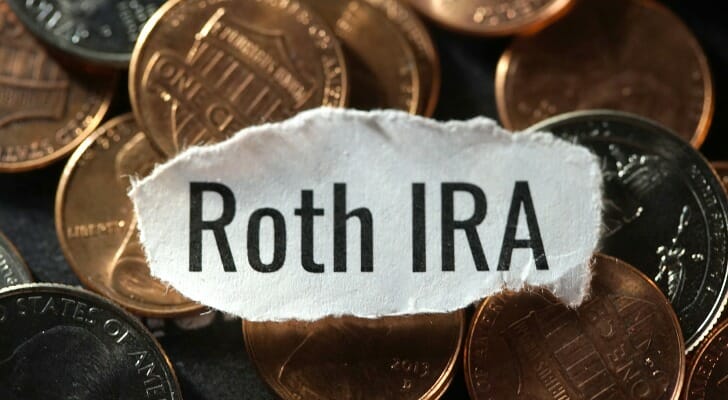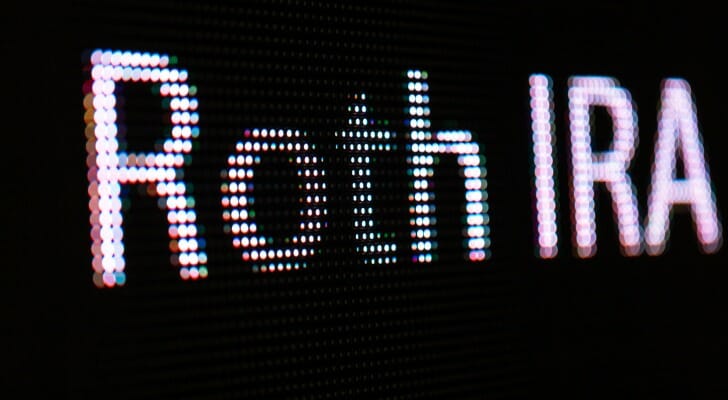A Roth IRA is a retirement account that lets your investments grow tax-free, meaning qualified withdrawals in retirement aren’t taxed. This differs from a traditional IRA, where contributions are tax-deductible but withdrawals are taxed later. Your actual returns depend on the investments you choose, but historically Roth IRAs have averaged roughly 7% to 10% annually, assuming a diversified, long-term portfolio.
If you want help with making the most of your Roth IRA, consider finding a financial advisor.
How a Roth IRA Works
A Roth IRA is an individual retirement account that you contribute to using after-tax dollars. This setup allows the account holder to take tax-free withdrawals of investment earnings once they have had the account for five years and are over the age of 59.5. In this way, Roth IRAs are the inverse of tax-deferred traditional IRAs and 401(k)s, as these accounts require you to pay taxes when you withdraw the funds.
You can contribute up to $7,000 to an IRA in 2025, plus an extra $1,000 catch-up contribution if you’re over 50. Catch-up contributions allow those who are closer to retirement to contribute just a bit more to their IRAs as they get closer to retiring. In 2026 you’ll be able to contribute $7,500 ($8,500 with catch-up contributions).
There are income limits for Roth IRAs, though. Contribution eligibility depends on your modified adjusted gross income (MAGI). You can contribute up to the limit as long as your MAGI is less than the lower limit, and it gets phased out until you reach the top limit. Beyond the income range, you will not be able to make any more contributions.
The table below breaks down the Roth IRA income limits for 2024 and 2025:
| Roth IRA Income Limits for 2024 and 2025 | ||
|---|---|---|
| Filing Status | 2025 MAGI Limits | 2026 MAGI Limits |
| Single or Head of Household | $150,000 – $165,000 | $153,000 – $168,000 |
| Married Filing Jointly or Qualifying Widow | $165,000 – $236,000 | $242,000 – $252,000 |
| Married Filing Separately | Up to $10,000 | Up to $10,000 |
How a Roth IRA Earns Interest

Unlike traditional savings accounts, Roth IRAs don’t earn returns on the account alone. Essentially, a Roth IRA account starts out as an empty investment basket — meaning you won’t earn any returns until you choose investments to house within the account itself.
As you earn returns in your Roth IRA, these can compound over time like any other investment. This can have a major impact over multiple years. Whenever your investments earn a dividend or grow in size, that amount goes toward your account balance. Then you earn returns on those returns, and so on. That means your money should continue to grow regardless of whether you contribute extra money or not.
Several factors will impact how your money grows in a Roth IRA, including how diversified your portfolio is, what is your timeline for retiring and how much risk are you willing to take on. While there isn’t necessarily a historical rate of return for Roth IRAs – remember, they are types of accounts, not investments – annual returns for typical retirement portfolios can range from 7% to over 10%. For example, a 60/40 portfolio (60% equities, 40% bonds) has averaged an annual growth rate of 8.77%, according to data from Vanguard.
Meanwhile, investing 90% of your assets in equities and only 10% in bonds historically produces a return of nearly 10%, although this may be too aggressive of an asset allocation for savers nearing retirement.
Let’s say you open a Roth IRA and contribute the maximum amount each year. If the base contribution limit remains at $7,000 per year, you’d amass over $100,000 (assuming a 8.77% annual growth rate) after 10 years. After 30 years, you would accumulate over $900,000.
On the other hand, if you decided to put your money in a savings account that didn’t yield interest, you would only have $70,000 after 10 years ($6,000 multiplied by 10). To calculate the growth of your contributions, check out SmartAsset’s investment calculator.
Comparison With Other Retirement Accounts
When thinking about the average Roth IRA return, it’s helpful to put it in context with other popular retirement savings vehicles. While investment performance depends largely on what you hold inside the account (stocks, bonds, mutual funds, ETFs), the tax treatment and contribution rules can affect your overall outcome. Here’s how Roth IRAs stack up against other common retirement accounts:
Roth IRA vs. Traditional IRA
- Investment returns: On a pre-tax basis, the returns are the same if invested identically (e.g., both holding an S&P 500 index fund).
- Taxes: This is where the difference lies. Traditional IRAs grow tax-deferred, but you’ll pay ordinary income tax when you withdraw in retirement. Roth IRAs, by contrast, let your investments grow tax-free and withdrawals are not taxed if rules are met.
- Implication for returns: A 7% average return in a Traditional IRA could feel like less once taxes are deducted. A 7% return in a Roth IRA may effectively deliver more spending power in retirement since withdrawals are tax-free.
Roth IRA vs. 401(k)
- Employer contributions: A big advantage of a 401(k) is that many employers match contributions, which can supercharge your effective return.
- Investment options: 401(k) plans sometimes have limited investment choices compared with the flexibility of a Roth IRA.
- Taxes: Traditional 401(k) contributions are pre-tax, lowering taxable income now, but withdrawals are taxed later. Many employers also offer a Roth 401(k), which mirrors the Roth IRA’s tax-free withdrawals but with higher contribution limits.
Roth IRA vs. Brokerage Account
- Investment freedom: Both allow a wide range of investment options.
- Taxes: A taxable brokerage account does not shield you from annual capital gains, dividends, and interest taxes. By contrast, a Roth IRA shelters growth from taxes as long as you follow withdrawal rules.
- Implication for returns: Even if the gross return is the same, a Roth IRA often produces a higher net return over decades due to its tax-free nature.
The average return you earn on a Roth IRA is primarily a function of the investments you choose. However, compared with other accounts, the Roth IRA’s tax-free growth and withdrawals can make its effective long-term return higher, especially if you expect to be in the same or higher tax bracket in retirement.
How to Maximize Your Roth IRA Returns
Just because a Roth IRA helps you save for retirement doesn’t mean that all accounts are on equal footing. Where you choose to open an account can have a big impact on the investment selections you have. This will then affect your long-term returns. For example, a traditional bank may only offer Roth IRAs as a certificate of deposit (CD), which typically has a lower rate of return.
For the widest variety of investment options, it may be best to open an IRA through a broker. With a broker, you can select your investments based on both your financial objectives and risk tolerance. These investments could include a mix of stocks, bonds, index funds and exchange-traded funds (ETFs).
If you prefer a more hands-off approach, consider opening a Roth IRA account with a robo-advisor, which uses software to manage your investments online. These types of accounts usually come with lower fees as well. That’s because no human advisors interact with your portfolio. Instead, it automatically runs through computer algorithms that continually adjust for your age, timeline and risk tolerance. Many robo-advisors will use index funds or ETFs for your investment mix in your Roth account.
Frequently Asked Questions About Roth IRA Returns
What is the average annual return of a Roth IRA?
There isn’t a fixed “Roth IRA return” since the account is just a tax wrapper. The average annual return depends on your investment mix. Historically, a stock-heavy portfolio in a Roth IRA has returned about 7%–10% annually over the long term, while conservative, bond-heavy portfolios average closer to 3%–5%.
How does inflation affect Roth IRA returns?
Inflation reduces your real return, which is the amount of purchasing power your account gains after accounting for rising prices. For example, if your Roth IRA grows 8% in a year and inflation is 3%, your real return is closer to 5%. This makes choosing investments that historically outpace inflation—like equities—important for long-term growth.
Are Roth IRA returns better than Traditional IRA returns?
If both accounts hold the same investments, their gross returns are identical. The difference is in taxation. Traditional IRA withdrawals are taxed as income, which reduces your effective return. Roth IRA withdrawals are tax-free (if you follow the rules), which can make their after-tax return higher, especially if you expect to be in the same or higher tax bracket in retirement.
Do fees reduce my Roth IRA returns?
Yes. Fund expense ratios, trading commissions, and account management fees all reduce your net return. For example, a 7% gross annual return might become 6.7% after a 0.3% expense ratio. Over decades, that difference can mean thousands of dollars less in retirement savings, which is why many investors favor low-cost index funds in their Roth IRAs.
How much could my Roth IRA grow over time?
That depends on your contribution amount, time horizon, and rate of return. For example, contributing $7,000 per year at a 7% average annual return could grow to more than $1 million in 40 years. Compounding and consistent contributions are the keys to building significant wealth in a Roth IRA.
Bottom Line

Roth IRAs are a popular retirement account choice for a reason. It’s because they’re easy to open with an online broker can deliver between 7% and 10% in average annual returns depending on how you invest. Roth IRAs harness the advantages of compounding, which means even small contributions can grow significantly over time. That’s why is important to open a Roth IRA sooner rather than later. That means you’ll be more ready for retirement the longer your money has to grow.
Tips for Investing for Retirement
- A financial advisor can help you manage your investment portfolio for retirement. Finding a financial advisor doesn’t have to be hard. SmartAsset’s free tool matches you with vetted financial advisors who serve your area, and you can have a free introductory call with your advisor matches to decide which one you feel is right for you. If you’re ready to find an advisor who can help you achieve your financial goals, get started now.
- SmartAsset’s retirement calculator can show you if you’re on pace to meet your savings goals.
Photo credit: ©iStock.com/jxfzsy, ©iStock.com/Kameleon007, ©iStock.com/skynesher
